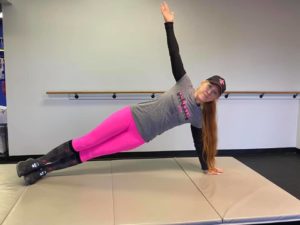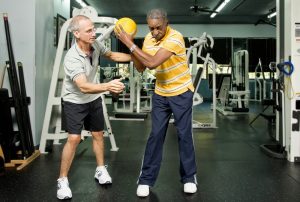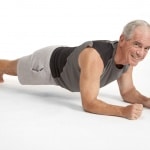 July 2025
July 2025
Exercise With Knee Arthritis: A Necessary Option
When you have osteoarthritis of the knee (KOA), your pain, swelling, energy, enthusiasm and even trust in exercise are affected. For more on KOA, check out here, here, here, and here. Yet the healthcare community knows it’s good for you; even you know it’s good for you. And yet we still know little about when it’s best to start a supervised physical therapy (PT) regimen and what benefits result, if any.
An analysis of insurance data from over 67,000 people newly diagnosed with KOA found that the “sooner a person starts receiving physical therapy after a diagnosis, the lower their risk of future use of opioids or injectable therapies.” Also, “the greater the delay to initiation of physical therapy care, the greater the future risk.”

A related study looked at whether PT prior to total knee replacement (TKR) impacted future opioid use. They found that pre-op PT was, indeed, “related to reduced risk of long-term opioid use” after TKR. Too, starting rehab within 30 days of surgery and having more PT than is often recommended also lowers long-term opioid use.
Another finding from another study by the same group reported that “some pain during exercise may actually yield beneficial analgesic effects for people with knee OA, helping healthcare providers appropriately educate patients about self-monitoring for symptoms and strategies to modify exercise dose as needed.”
Personal training is not PT. But engaging in supervised exercise that is modified for KOA may mitigate the co-occurance of “fatigue, sleep disturbances, and psychological impairments including depressed mood, anxiety, fear of movement, and catastrophizing behaviors” typically experienced by those affected.
ACSM Bulletin June 2025
Alzheimer’s Disease, Genetics, and Movement
The ever-expanding science of sedentariness has already implicated lack of movement in chronic diseases such as osteoarthritis, osteopenia/osteoporosis, heart disease, several cancers, and cognitive decline/dementia. Not to belabor the point, but exercise is really, really good for you. (Fact: STEPS personal fitness training is also really good for you.) Now a multi-center study from Vanderbilt University’s Memory and Alzheimer’s Center has demonstrated that sedentary behavior may be a modifiable risk factor for Alzheimer’s disease (AD), especially for those with a genetic predisposition. That is, if you have the APOE-ε4 gene, which already increases your risk of AD, a more sedentary lifestyle may increase that risk.
The Vanderbilt Memory and Aging Project recruited 404 subjects to wear an actigraph (which measures duration and intensity of activity) for 7 days and have neuropsychological testing, plus a brain MRI, and a follow-up assessment 7 years down the road. They found that “greater sedentary time related to a smaller AD-neuroimaging signature … and worse episodic memory.” APOE-ε4 status exacerbated the impact of lifestyle. “In longitudinal models, greater sedentary time related to faster hippocampal volume reductions … and declines in naming … and processing speed”.
In conclusion, “greater sedentary behavior is related to neurodegeneration and worse cognition. Associations differed by APOE-ε4 carrier status in cross-sectional models. Sedentary behavior is an independent risk factor for Alzheimer’s disease.”
Alzheimer’s & Dementia May 2025
Tid Bits
Hydrolyzed collagen is thought to benefit connective tissue – muscle, tendon, ligament, and bone – due to its amino acid (AA) content. A study had 45 young, healthy subjects ingest either collagen, free AAs, or placebo after a resistance training exercise. For 6 hours afterward, protein synthesis rates were assessed. Collagen and AA “substantially increases circulating amino acids concentrations, particularly glycine, but does not further increase” protein synthesis. MSSE June 2025
A new report in the JAMA (May 2025) asked the question, are dietary carbs in “midlife prospectively associated with healthy aging” – considering chronic disease, cardiac and metabolic diseases, and cognitive function – in women. A cohort of the Nurses’ Health Study of 47,513 women who’d been followed for more than 20 years, were asked about their intake of carbohydrates – refined to ‘healthy’ – in questionnaires back at the beginning of the study. Intakes of high-quality carbohydrates and lots of fiber led to higher odds of healthy aging whereas high refined-carb diets led to lower odds.
rotatoShoulder pain, especially that caused by rotator cuff (RC) issues, is not, as one might believe, situated only in the shoulder. Our scapula rides on the posterior rib cage and positions the socket to accommodate motion of the ball that is at the end of the humerus. The question a research group aimed to answer was, does the addition of proprioceptive training, combined with traditional RC exercises, assist the rehabilitation process. Compared to an exercise-only group, the addition of proprioception exercises did not yield “improvements in pain intensity, kinesiophobia, catastrophizing, self-efficacy, kinesthesia, joint position sense…while a decline in lateral rotator peak torque was noted.” In other words, do the RC exercises faithfully until further notice. JOSPT June 2025















